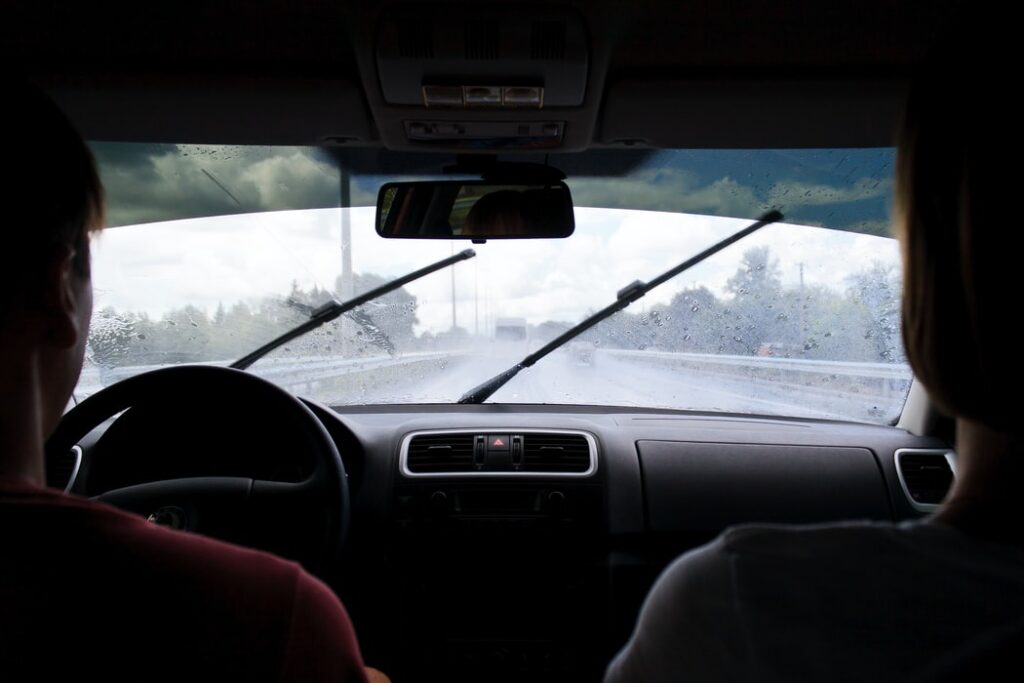Even for the best drivers out there, driving in the rain is tough. Visibility is hindered for everyone, cars can drift or skid on the road, and collisions are more likely overall. According to the U.S. Department of Transportation, at least 21% of collisions in the last 10 years have been due to weather conditions.
To stay safe in the rain, we’ve compiled a list of 5 essential safety tips for drivers everywhere.
Tip #1: Eliminate driver distractions
Distracted drivers are dangerous in any condition. Add rain to the equation and you’ve got yourself a very precarious situation. That’s why our first and most important tip is to eliminate anything that could be distracting when you’re driving—especially your cell phone. In fact, 14% of fatal crashes involve cell phones according to recent research reports. We really shouldn’t be on our phones at all while driving (and it’s illegal in at least 48 states), but it’s especially important to put phones away when it’s raining.
Distractions can be less obvious, though. Being preoccupied with something else or trying to multitask can be dangerous, too. When driving conditions are more dangerous, try to focus on the road as much as possible. Turn on your music, ask kids in the car to keep their hands to themselves, or take any other measures that make sense for you.
Tip #2: Keep your tires ready for rain
Driving in wet conditions can cause your car to hydroplane. This happens when a thin layer of water is collected beneath your tires, and your tires “skid” and slide on top of it. Simply put, you lose traction. Hydroplaning can be dangerous and scary, especially if you’re not used to handling it.
To keep your tires ready for rain, maintain both the air pressure and tread of your tires. Checking your air pressure is easy with a tire pressure gauge, which is cheap to buy and accessible at most auto parts stores or a Walmart. Some newer car models can even tell you your air pressure within your car dashboard.
Checking your tread is a little trickier. One method is called the penny test, where you can take a penny and insert it into a groove of your tire. If your penny is partially covered, you’re probably okay. If it sticks out a lot, you have low tire tread and probably need new tires. You can also go to your local dealership and ask them to check for you.
Tip #3: Maintain your car brakes
Most cars come with a recommended brake maintenance schedule. The easiest way to maintain your brakes and brake pads is to keep up with regular maintenance. If for some reason you can’t, or it’s been a while since you’ve been able to do that, you can check your brakes at home. More specifically, your brake pads, which can usually be seen through your tire. According to J.D. Power, if your brake pads look less than ¼ inch thin, it’s time to replace them.
Of course, you should also pay attention to how your brakes sound and feel on a regular basis. If you hear any new or strange noises when you brake, if it starts to feel like your car brakes more slowly, it’s time to have them checked out.
Tip #4: Use the right headlights (and keep them clean)
Since rain already decreases driver visibility, headlights matter when it’s raining. Driving in the rain usually also means driving with less light, since it tends to be cloudier during the day and gets dark faster.
Make sure you are using the best headlights for your vehicle, and that they are appropriate for your car and fit properly. Keeping your headlights clean also impacts visibility significantly. Regular use and sunlight can cause your headlights to look cloudy and foggy, which makes it harder to see. To learn how to clean your headlights at home, check out our DIY tips for headlight cleaning.
Lastly, if you’re experiencing really heavy rainfall when driving, remember that you can switch to your low beam headlights. High beams are less ideal, because if there’s any fog the light will be reflected back at you and actually make it harder to see. Stick to low beams to be safe.
Tip #5: Don’t drive when you’re tired
It should go without saying not to drink and drive, but it’s also important not to drive when you’re tired. As we mentioned, driving in rainy weather conditions requires more focus from you as a driver. If you’re too tired to pay attention, ask someone else to drive or just stay home if possible. Many studies even show that driving while drowsy is comparable to driving while intoxicated.
